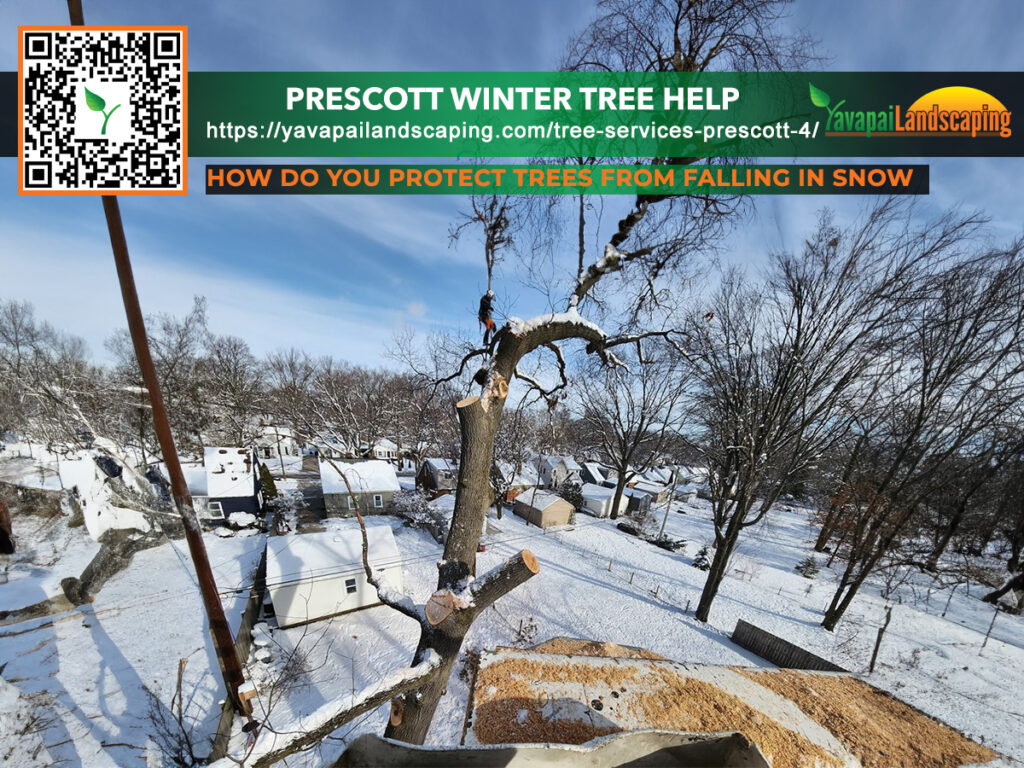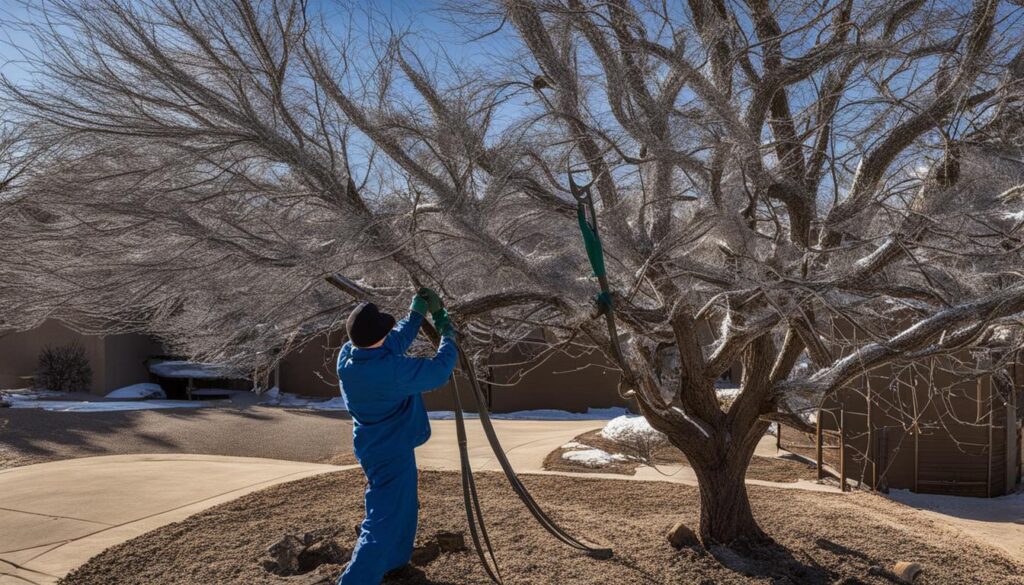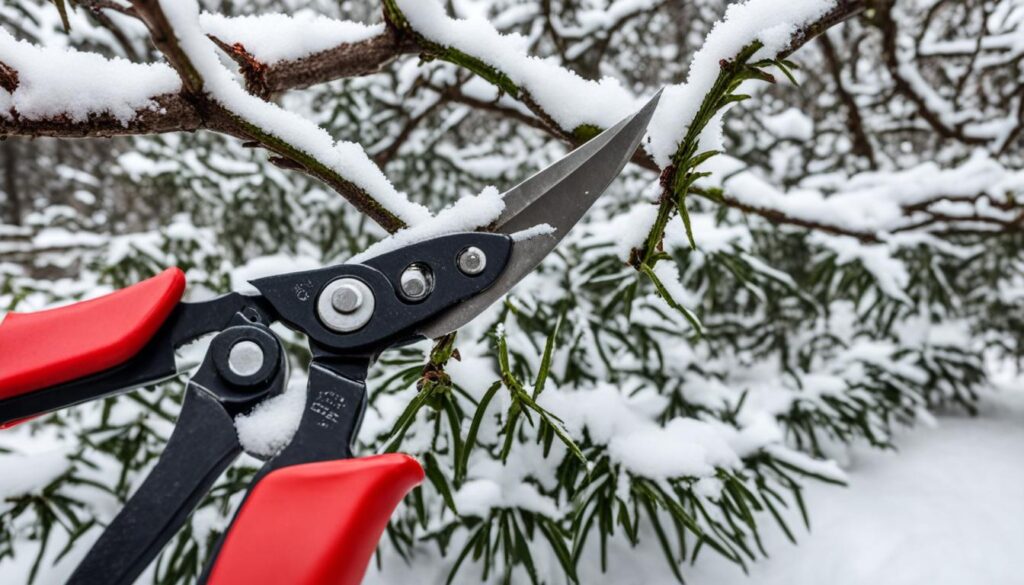
Winter is a critical time to care for your trees to prevent diseases and maintain their overall health in Prescott, AZ. Providing winter tree help through winter tree pruning can be an effective method to achieve these goals and keep your trees in top condition. By positively influencing the tree’s overall vitality and removing dead or diseased branches, winter tree pruning makes for an effective disease prevention measure.
Let’s explore the benefits of winter tree pruning and understand how it can help guard your trees against harmful diseases.
Key Takeaways:
- Winter tree pruning can help prevent diseases in trees.
- Proper winter tree pruning techniques can aid in the reduction of the risk of fungal infections.
- It enhances the tree’s overall vitality, promoting healthy growth and reducing the risk of pests and diseases breeding in the area.
- Winter pruning has enormous benefits for different types of trees, and a professional tree service can help in achieving desirable results while keeping safety as a priority.
Understanding the Importance of Winter Tree Pruning for Disease Prevention
In the harsh winter months, tree care takes on a greater significance, especially in disease prevention. That is where winter tree pruning plays a crucial role. Not only does it remove dead or diseased branches and reduce the risk of fungal infections, but it also enhances the overall vitality of the tree. Pruning during the winter season can help you maximize these benefits and ensure your trees remain well-protected against diseases.
Winter tree pruning is a proactive care technique. Removing infected or weakened branches, which can be a breeding ground for pests and diseases, helps maintain tree health. Additionally, pruning enhances air circulation and sunlight penetration, reducing the conditions favorable for pathogens to thrive.
Winter tree pruning offers several benefits, including:
- Reducing the risk of pest infestations
- Enhancing the aesthetic appeal of your trees
- Stimulating healthy growth
- Improving the overall health and resilience of your trees
By taking care of pruning during the winter season, you are taking a proactive measure to ensure the longevity and vitality of your trees.
Winter Tree Care for Disease Prevention
Winter pruning for disease prevention is all about removing what’s necessary to keep the tree healthy. To avoid unnecessary damage, it’s important to follow the best pruning practices and techniques.
| Best Practices for Winter Tree Pruning | Winter Pruning Techniques for Disease Prevention |
|---|---|
| – Prune when the tree is dormant – Avoid pruning during extremely cold weather – Use the right tools – Make proper pruning cuts – Prioritize safety precautions – Clean equipment between cuts to prevent the spreading of diseases | – Remove infected or weakened branches – Stimulate healthy growth – Enhance tree structure – Maintain tree health through winter pruning – Identify diseased branches and infections |
The benefits of winter tree pruning are clear. Follow the best practices, care for your trees, and take advantage of the dormant period to ensure the longevity of your trees.
How Winter Tree Pruning Helps Prevent Disease
Winter tree pruning is a critical technique for maintaining the health of your trees and preventing the spread of disease. One of the primary benefits of winter pruning is the removal of infected or weakened branches that can be a breeding ground for pests and diseases. By eliminating these branches, you prevent the spread of disease to healthy parts of the tree.
Another way that winter tree pruning helps prevent disease is by improving air circulation and sunlight penetration. Proper pruning techniques can promote the growth of new, healthy branches and remove dead wood, allow for proper airflow, and minimize conditions that are favorable for pathogens to thrive and cause diseases.
By following the right winter pruning techniques, you can effectively prevent diseases and keep your trees healthy. Some of the key winter pruning techniques to use for disease prevention include:
- Removing dead wood: Dead or dying branches create openings for pests and diseases, so removing them is essential for preventing infection.
- Proper cuts: Make clean cuts, and don’t remove too much of each branch, ensuring healthy growth in the future.
- Sterilization: Make sure to clean and sterilize your pruning tools between cuts to avoid spreading diseases between trees.
Incorporating these winter pruning techniques into your tree care routine helps prevent disease, promoting the overall health and well-being of your trees.
Best Practices for Winter Tree Pruning
Winter tree pruning is an essential part of maintaining tree health and preventing diseases. Proper pruning practices can help you achieve optimal results and ensure the longevity of your trees. Here are some best practices for winter tree pruning:
1. Prune During Dormant Season
The ideal time for winter tree pruning is when the trees are in their dormant phase. This timing allows trees to recover from pruning cuts during the winter when they are less vulnerable to stress and disease. Avoid pruning in the spring or summer when new growth is occurring.
2. Use Proper Pruning Techniques
Using proper pruning techniques is crucial to maintaining the health of your trees. Always make clean cuts to avoid injuring the bark or leaving jagged edges that can attract pests and diseases. Remove any dead or diseased branches, and prune to shape the tree’s structure.
3. Use the Right Tools and Equipment
Using the right tools and equipment is essential for safe and effective winter tree pruning. Make sure your pruning tools are sharp and well-maintained to avoid injuring yourself or the tree. Wearing protective gear such as gloves, safety glasses, and a hard hat is also crucial.
4. Ensure Safety Precautions
Ensuring safety precautions is critical in winter tree pruning. Never prune near power lines or in adverse weather conditions. Make sure the area is clear of people or objects that could be hit by falling branches. If the job seems too large or risky, call a professional.
Follow these best practices for winter tree pruning, and your trees will have the best chance of staying healthy and thriving year-round.

Identifying Diseased Branches and Infections
To effectively prevent diseases and maintain optimal health through winter tree pruning, it’s essential to identify diseased branches and infections. Here are the common signs and symptoms of tree diseases:
| Disease | Signs and Symptoms |
|---|---|
| Discoloration | Yellow, brown, or black leaves or needles, dead patches |
| Cankers | Sunken or swollen areas, oozing sap, cracked bark |
| Fungal Growth | Mushrooms or conks growing on the trunk or branches |
| Pest Infestations | Holes or tunnels in the bark, webbing, visible insects |
By recognizing these symptoms, you can take appropriate action during winter tree pruning to remove infected or weakened branches, reducing the risk of fungal infections and preventing pests and diseases. Winter tree pruning ensures that your trees are in top form and optimally healthy.
Benefits of Winter Tree Pruning
Winter pruning is not only vital for disease prevention but also for the overall health of your trees. Regular pruning during the winter season promotes healthy growth by removing dead or damaged branches. This process also shapes the tree’s structure by directing growth and improving aesthetics. Winter pruning increases the tree’s resilience by strengthening the root system and enhancing its ability to withstand harsh weather conditions.
Moreover, winter pruning saves time and money in the long run by preventing the spread of diseases and reducing maintenance costs. By investing in proper winter tree pruning, you can enjoy a healthy, beautiful yard with well-maintained trees that provide a host of ecosystem services. Don’t overlook this remarkable article – How Does Winter Tree Protection Impact Soil Health?
Taking Advantage of Dormancy for Pruning
Winter tree pruning is a critical activity when it comes to maintaining the health and vitality of your trees in Prescott, AZ. Pruning during the dormant season is advantageous since it helps trees recover from pruning cuts by minimizing stress and preventing diseases.
During dormancy, trees are less vulnerable to pests and diseases, making it the perfect time to prune them. In addition, pruning during this period encourages the tree’s energy to focus on the remaining branches and roots, stimulating healthy growth in the spring and summer.
Pruning during the winter season improves the tree’s structure, enhances its aesthetic appeal, and helps prevent diseases. When it comes to winter pruning, you’ll want to pay attention to the specific needs of your tree species, including how it responds to pruning cuts and the most effective techniques to use based on its characteristics.
To get the most out of winter tree pruning and ensure the health and longevity of your trees, we recommend hiring a professional tree service. Experienced professionals understand the best practices for winter tree pruning, have the necessary tools and equipment, and know the specific requirements of different tree species.
Don’t take chances with your trees’ well-being – trust the experts to help you achieve the best possible results from winter tree pruning!

Tips for Pruning Different Tree Species in Winter
Pruning during winter is crucial to prevent diseases in your trees. However, different tree species require different pruning techniques and schedules. Here are some tips to help you make sure your pruning is effective:
Deciduous Trees
Deciduous trees such as maple, oak, and birch should be pruned during their dormant season, which is from late fall to early spring. To encourage vigorous growth and prevent disease, prune closely to the trunk, keeping only the strongest branches. Use the three-cut technique for larger branches – cut halfway through the underside of the branch, then cut through the top of the branch. Finally, cut through the remaining stub above the branch collar. This helps prevent tearing or damaging the bark.
Evergreens
Evergreen trees such as spruce, pine, or juniper should also be pruned during their dormant season. Evergreens don’t need as much pruning as deciduous trees, so focus on removing dead, diseased, or damaged branches. To avoid damaging the tree, don’t prune too close to the trunk or remove too many branches at once. Use sharp, clean tools to make clean cuts.
Fruit Trees
Fruit trees such as apple, peach, or cherry should be pruned in late winter before the buds start to swell. Prune to remove any crossing or rubbing branches, as well as any diseased or dead wood. To promote fruit production, prune back the previous year’s growth. Avoid cutting the main central stem or the leader branch, which forms the tree’s structure. Use sharp, clean tools to prevent damage or disease spread.
Remember to always assess each tree’s unique characteristics before beginning any pruning. For more detailed guidance, consider consulting with a professional tree service, especially for large or complex trees. Proper winter tree pruning can help prevent diseases and promote tree health.
Hiring a Professional Winter Tree Pruning Service
If you are not confident in your winter tree pruning skills, entrusting the job to a professional tree service can provide you with several advantages. Experienced professionals have the expertise and knowledge to prune your trees effectively, ensuring proper techniques, and mitigating risks.
Professional tree services possess advanced tools and equipment that are essential for efficient winter tree pruning, such as chainsaws, hand pruners, and loppers. Additionally, they can assess the overall condition of your trees and provide recommendations for other necessary maintenance or treatment.
When considering hiring a winter tree pruning service, be sure to choose one with proper licensing and insurance to safeguard against any potential liability. Choosing a professional tree service ensures that the health and longevity of your trees are maintained, providing significant long-term benefits.
Common Mistakes to Avoid during Winter Tree Pruning
Winter tree pruning is a delicate process that requires skill and expertise. Knowing what not to do is as important as knowing what to do. Here are some common mistakes to avoid:
Excessive Pruning
Trimming too much can harm the tree by exposing it to disease and stress. Avoid pruning more than 25% of the tree’s canopy at one time.
Incorrect Pruning Cuts
Pruning cuts should be made at a 45-degree angle, just beyond the branch collar. Improper cuts can result in bark tearing and make the tree more vulnerable to pests and diseases.
Neglecting Safety Measures
Pruning trees can be dangerous. Always wear safety gear and use proper pruning tools to avoid accidents.
Improper Timing
Pruning at the wrong time can harm the tree. Always prune during the dormant period, generally in late winter. Pruning during the growing season can make the tree more vulnerable to pests and diseases, and pruning during fall can prevent the tree from developing proper winter hardiness.
Avoiding these common mistakes can help ensure successful winter tree pruning. Keep in mind that winter tree pruning is best left to the hands of professionals, who have the expertise and knowledge to perform the job safely and effectively.
Caring for Pruned Trees during Winter
After pruning, trees are susceptible to cold weather and potential stress. Proper post-pruning care is crucial to protect trees and maintain their health during winter. Here are some important tips to ensure your pruned trees remain healthy:
Watering
Make sure your trees receive plenty of water during the winter. Even though the weather is cooler, trees continue to lose moisture through their leaves and branches, and cannot absorb water like they can during the growing season. Watering deeply once a week is recommended, especially if the winter is dry.
Mulching
Mulching can help keep the soil around your trees moist, regulate soil temperature, and protect from harsh weather conditions. Spread a layer of organic mulch around your trees, taking care not to pile it up against the trunk. Organic mulch, such as bark chips, shredded leaves, or compost, is preferred, as it also enriches the soil as it decomposes.
Monitoring
Keep a close eye on your pruned trees during the winter months. Watch for signs of stress, such as wilting, yellowing leaves, or dieback of branches. If you notice any issues, consult with a professional tree service to determine the best course of action.
By caring for your pruned trees during the winter, you can help maintain their health and promote growth in the spring. Proper watering, mulching, and monitoring are essential for ensuring successful winter pruning and maintaining the overall well-being of your trees.
Conclusion
In conclusion, winter tree pruning in Prescott, AZ, is a proactive measure that can help prevent diseases and maintain the health of your trees. By understanding the importance of winter tree pruning for disease prevention, how it helps prevent disease, and the best practices for winter tree pruning, you can effectively protect your trees from harm. Taking advantage of dormancy for pruning and identifying diseased branches and infections are also key factors that contribute to successful winter pruning.
Remember to avoid common mistakes during winter tree pruning, and consider hiring a professional winter tree pruning service for optimal results. Lastly, caring for pruned trees during winter is crucial to ensuring their health and longevity. With winter tree pruning, you can promote healthy growth, shape your tree’s structure, improve its aesthetics, and enhance overall tree health and resilience.
Yavapai Landscaping Prescott offers free quotations for Prescott and its nearby localities for landscaping and tree services. These include tree removal, trimming, stump grinding, land clearance, storm clean up, and emergency tree service.











